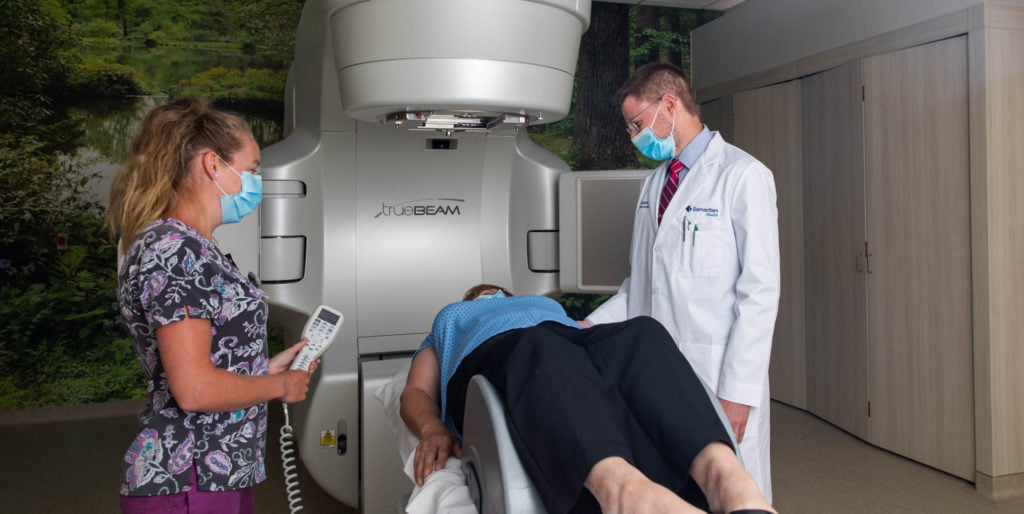Radiation Therapy
The Walker Center for Cancer Care is proud to offer patients leading-edge, evidence-based radiation therapy with the help of state-of-the-art technology and a compassionate and talented staff. Our Radiation Therapy staff can treat all types of cancer and certain non-cancerous conditions.
The centerpiece of Samaritan’s Radiation Therapy Department is the Varian Medical Systems’ TrueBeam Linear Accelerator, one of the most modern and versatile linear accelerators available. This machine allows us to provide image-guided stereotactic radiosurgery and radiotherapy with high precision to treat tumors and lesions in various parts of the body, including lungs, breasts, head, and neck.

A comprehensive list of treatments and techniques offered:
- 3D-conformal radiation therapy
- Intensity modulated radiation therapy (IMRT)
- Volumetric modulated arc therapy (VMRT)
- Stereotactic body radiation therapy (SBRT)
- Fractionated stereotactic radiosurgery (fSRS)
- Electron beam therapy
- Prone breast treatment
- Motion-managed radiation therapy:
– Respiratory gating
– Expiration breath hold
– Deep inspiration breath hold
– 4D CT Planning - SpaceOAR™ Hydrogel implants for prostate cancer radiation therapy
- Radiopharmaceutical therapies
- Liver-directed selective internal radiation therapy
- Optune for glioblastoma multiforme
Tell me more about radiation therapy
Radiation therapy has been used in the treatment of cancer for over 100 years; in fact, its use predates chemotherapy use by several decades.
It employs ionizing radiation, such as high-energy x-ray beams and charged particles, to destroy cancer cells. We call this external beam radiation therapy (EBRT). These two forms of ionizing radiation are generated in a machine called a linear accelerator, and here at the Walker Center we have one of the most modern and versatile linear accelerators in use.
We design radiation treatments to ‘shine” multiple beams of ionizing radiation on the tumor(s) we seek to treat. In this way, the radiation therapy is external to the body and completely non-invasive.
Ionizing radiation can also be emitted from radioactive substances called isotopes. These isotopes can be implanted in the body, ingested, or infused through an IV or central catheter. At the Walker Center, we do not currently offer radioactive implants (brachytherapy). We do, however, offer radiopharmaceutical therapies with isotopes that are ingested or infused for a limited number of conditions.
How do I receive radiation therapy?
After meeting with a radiation oncologist, the first step in receiving treatment is a planning session (also called a simulation), in which we will establish how to set you up for treatment in a way that is comfortable and reproducible.
Once you are positioned optimally, we will acquire a CT scan of you in that position and place several small indelible ink marks on your skin to help put you back in that optimal position when you come for treatment. We call these “tattoos,” but in reality, they are the size of a pinpoint. It takes about 1-2 weeks after the planning session to start treatment.
How is external beam radiation therapy given?
External beam radiation treatments are most commonly given once daily, Monday through Friday, during normal office hours.T
he length of the treatment can be anywhere from a single treatment to eight weeks of daily treatment, depending on the particular cancer being treated. After the planning session, you will be given a treatment schedule with the days of your treatments and times specified. We prefer to keep patient’s treatment times the same each day for mutual convenience.
Treatments are scheduled as 15- to 30-minute appointments, but the time that the machine is delivering radiation is only a few minutes per treatment.
What types of external beam radiation are offered at the Walker Center?
In addition to conventional external beam radiation techniques, which have been in widespread use for the last 15 years, we now offer stereotactic body radiation therapy (SBRT) and stereotactic radiosurgery (SRS).
SBRT is precisely delivered external beam radiation to tumors with curative intent. We maximize the chance of cure by giving a very high radiation dose to the tumor per treatment over 3-5 treatments (rather than a low dose per treatment over many weeks of treatment). SBRT is a non-invasive treatment for early-stage, non-small-cell lung cancer, prostate cancer and liver cancer, among others. Results are excellent and side effects are minimal.
SRS refers to precisely delivered beam radiation to tumors within the brain, most commonly those that have spread from elsewhere in the body (brain metastases), but also certain primary brain tumors. Like SBRT, a high daily dose of radiation is given over 3-5 treatments.
Precise radiation targeting, pre-treatment imaging on our linear accelerator and special techniques to account for tumor motion (such as in lung cancer with normal breathing) and/or limit radiation dose to surrounding normal organs (as in SpaceOAR hydrogel implants for prostate cancer) allow us to safely delivery such a powerful radiation treatment course.
What are radiation side effects?
External beam radiation treatment cannot be felt, smelled, heard, tasted or seen. The one general side effect is fatigue (tiredness). The magnitude of fatigue depends in large part on how a person feels before radiation. If a person is healthy and active, fatigue from radiation is less; if a person is already spending much of the day tired and inactive or in bed, then fatigue from radiation can be more severe.
Fatigue generally comes on in the latter weeks of treatments (with longer courses), or after treatment is completed (with shorter courses). It can persist for several weeks before going away.
The other side effects of radiation have to do with the particular region of the body we are treating and the radiation dose we using.
For instance, skin redness and dry skin peeling are common in breast cancer radiation treatment, because we are treating breast tissue all the way to the skin surface. In prostate cancer, we are treating an internal target deep in the pelvis, so there is generally minimal skin redness, but there are often changes in bowel and bladder habits.
A thorough discussion of possible side effects is an important part of treatment decision making. We will strive to minimize your risk of side effects and maximize the chance of a good treatment outcome.
In general, external beam radiation poses no restrictions on your daily activities and there is no radiation left in your body after external beam treatments. We stress that you ‘listen to your body’ while going through cancer treatment and do what you are comfortable with on a given day. If side effects from radiation are affecting your life negatively, we will help you manage them until they subside.
Does radiation therapy cause cancer?
It can, but it is an unlikely occurrence.
Radiation is a moderate cancer-causing agent (carcinogen). It can induce DNA damage in normal cells in the course of destroying cancer cells. This results in a small, but significant, increase in the absolute risk of developing a second cancer in the treated area in the decades after treatment.
The risk is estimated at <1% overall (meaning that less than 1-in-100 patients who receive radiation therapy will go on to develop a radiation related cancer later on), and given the mortality risk posed by the cancer already present and requiring treatment to be cured, most patients are willing to accept the small risk of a second cancer decades later.
How does radiation kill cells?
Radiation induces DNA damage in irradiated cells. This includes normal cells as well as cancer cells. Cancer cells, however, are often unable to repair the DNA damage induced by radiation so they die. Normal cells are much better than cancer cells at repairing DNA damage, so they don’t die. The result is that radiation preferentially kills cancer cells and spares normal cells.
How does radiation fit in with other treatments?
Radiation can be given alone to cure certain cancers, or to reduce symptoms caused by incurable cancers (palliative therapy). Radiation can be given in conjunction with systemic therapies (chemotherapies, immunotherapies, targeted therapies, etc.) to intensify treatment and increase the chance of cure. Radiation can also be given before or after surgery to sterilize microscopic cancer cells that are invisible to the surgeon’s eye. Doing this can reduce the chance of cancer coming back.
Introducing a new pre-treatment option for prostate cancer patients
The Walker Center for Cancer Care is pleased to offer SpaceOAR™ Hydrogel – the first and only FDA-cleared spacer that aims to reduce rectal complications and help patients maintain their quality of life after radiation treatment. Watch the video below to learn more.
Walker Center for Cancer Care
Use the Sherman St. entrance to access parking and enter the Walker Center.
830 Washington Street
Watertown, NY 13601
P. 315-785-4673
F. 315-788-4248
Click to send us a message.
Women’s Wellness
Monday – Friday
7:30 AM – 4:40 PM
Lab & Imaging
Monday – Friday
7:30 AM – 4:40 PM



